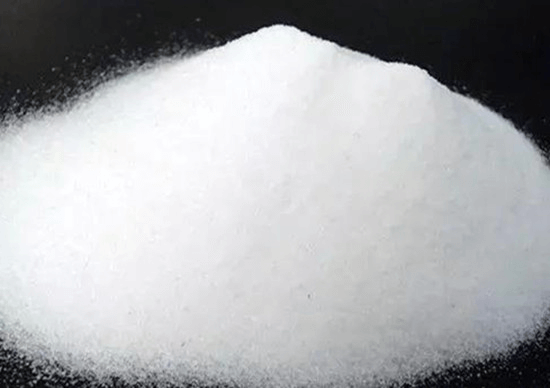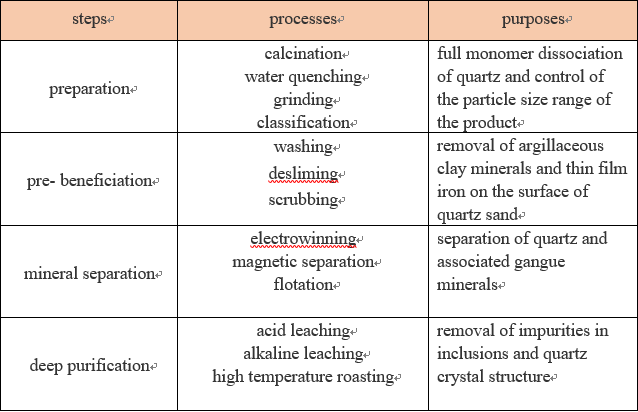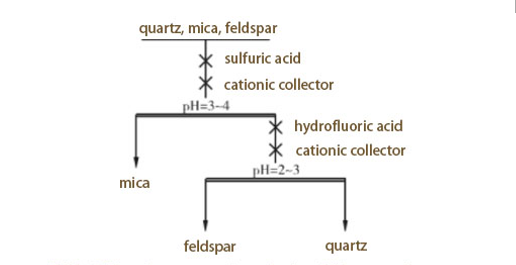

Warm Tip: If you want to know more details about equipment, solutions, etc, please click the button below for free consultation, or leave your requirements!

High purity quartz purification refers to the removal of associated gangue, inclusion impurities and crystal structure impurities in the raw quartz ore, usually including calcination, water quenching, grinding, classification, washing and desliming, scrubbing, electrowinning, magnetic separation, flotation,acid leaching, alkaline leaching, high temperature roasting, etc. According to the different processing purposes will be divided into four steps: preparation before beneficiation, pre- beneficiation, mineral separation, and deep purification operation, as shown in Table 1.

Table 1: Steps of high purity quartz sand processing technologies
The quartz before grinding is calcined at about 1000 ℃ and water quenched. Under high-temperature calcination, the quartz and gangue undergo a crystal transformation. The expansion rate of impurities is different from that of quartz. Under the action of water quenching, the temperature drops sharply and a large number of cracks are generated inside the particles. Cracks usually occur at the junction of quartz and gangue, inclusions and crystal structure defects. After crushing and grinding, inclusion impurities are easy to be exposed on the surface of quartz ore, which strengthens the effect of dissociation of quartz and gangue mineral monomer.
During the grinding process of raw quartz ore, some of the easily muded minerals form microfine particles of mud, which will adversely affect the subsequent sorting. The clay minerals can be effectively removed by pre-washing and desliming, and the effect of desliming is significant. Scrubbing is with the help of mechanical force and sand between the abrasive force to remove the quartz sand surface film iron, bonding and mud impurity minerals and further scrubbing not into a single mineral aggregate, mainly mechanical scrubbing, rod grinding scrubbing and ultrasonic scrubbing.
Magnetic separation and flotation are the most commonly used processes for separating quartz sand and associated gangue. The magnetic impurity minerals such as hematite, limonite, pyrite, ilmenite and black mica can be removed by multi-stage weak and strong magnetic separation, and the inclusions and congeners with magnetic minerals can also be removed. Flotation can effectively remove feldspar, mica and other non-magnetic associated impurity minerals from quartz sand, and is the most important process in the conventional beneficiation of quartz, and is also one of the most difficult processes to control.
Silicate minerals such as feldspar and mica are the main sources of aluminum impurities, and their solubility in acid and alkali is very poor; if the flotation can not completely separate the silicate minerals, it will directly affect the content of Al and Fe impurities in the product.
The common flotation process of quartz, mica and feldspar is shown in Table 2. Among them, the zero point charge of mica and quartz is quite different, and it is relatively easy to separate. However, the zero point charge of feldspar and quartz are very close; therefore, the separation is difficult. Usually, it is necessary to add hydrofluoric acid to activate feldspar to separate feldspar and quartz, and the separation effect of quartz and feldspar is best when the PH is about 2~3.

Table 2 Flotation separation of mica, feldspar and quartz
The inclusions and impurities in the lattice cannot be removed by conventional beneficiation methods alone, and high purity quartz sand cannot be obtained.
Deep purification is carried out by adding HCL and roasting at 800~1,600°C. The inclusions are heated to expand and rupture rapidly, exposing the impurities to the surface. In this process, the impurities migrate to the surface of quartz along with the process of quartz crystal structure transformation,and finally the impurities are removed by chemical leaching.
The above are the 4 operation processes for the purification of high-purity quartz sand.
1. Preparation before beneficiation
2. Pre-beneficiation
3. Mineral separation
4. Deep purification operation
In actual production, you can choose the purification process suitable for your own beneficiation plant according to the condition of the raw quartz ore and product requirements to achieve the highest economic benefits. If you have any questions about the content of this article, or want to purchase quartz purification equipment, please contact the online customer service to communicate, or leave a message on the website, we will talk to you in detail as soon as possible.
Last: Five Factors for the Evaluation of High Purity Quartz Raw Materials
14 Operations Of Silica Sand Washing Plant
 0
0
 4477
4477
2How to Remove Iron from Quartz?
 0
0
 4410
4410


What Are the Differences Between CIP and CIL?
 11364
11364
 0
0